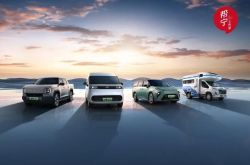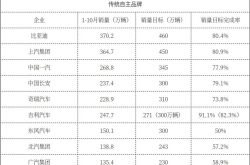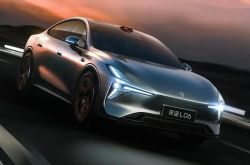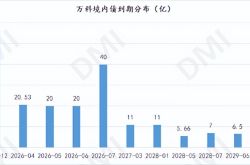Auto Companies Make a Big Push for Year-End Targets: Who Rejoices and Who Worries?
![]() 11/21 2025
11/21 2025
![]() 456
456
On September 12, eight departments including the Ministry of Industry and Information Technology jointly issued the Work Plan for Stabilizing Growth in the Automotive Industry (2025-2026), setting an annual target of approximately 32.3 million total vehicle sales and about 15.5 million new energy vehicle (NEV) sales for 2025. Driven by this policy guidance, the Chinese auto market has continued to maintain a steady growth momentum.
According to the latest data released by the China Association of Automobile Manufacturers, from January to October, cumulative vehicle sales nationwide reached 27.687 million units, with NEV sales at 12.943 million units. A rough calculation by a reporter from Auto Review shows that, as of now, the overall vehicle sales target achievement rate in China has reached 85%, indicating that the industry's annual goal of stable growth has achieved phased results.
Now, with only the last two months remaining in 2025, and as major mainstream automakers continue to release their latest sales data, the annual competition in the Chinese auto market has quietly entered its final big push stage. Looking back at the sales targets set by automakers at the beginning of the year, which companies have already achieved their goals ahead of schedule? The reporter has compiled the following information.
The Top Three Domestic Automakers Take the Lead,
Leapmotor and XPENG Cross the Finish Line Early
As we all know, since the beginning of this year, the Chinese auto market has faced increasingly fierce competition under the continuous impact of the 'price war,' with companies across the industrial chain facing unprecedented operational pressures. Nevertheless, the industry as a whole has demonstrated strong resilience, and driven by a series of positive factors, several automakers have successfully broken through, prematurely popping the 'champagne' for year-end celebrations.
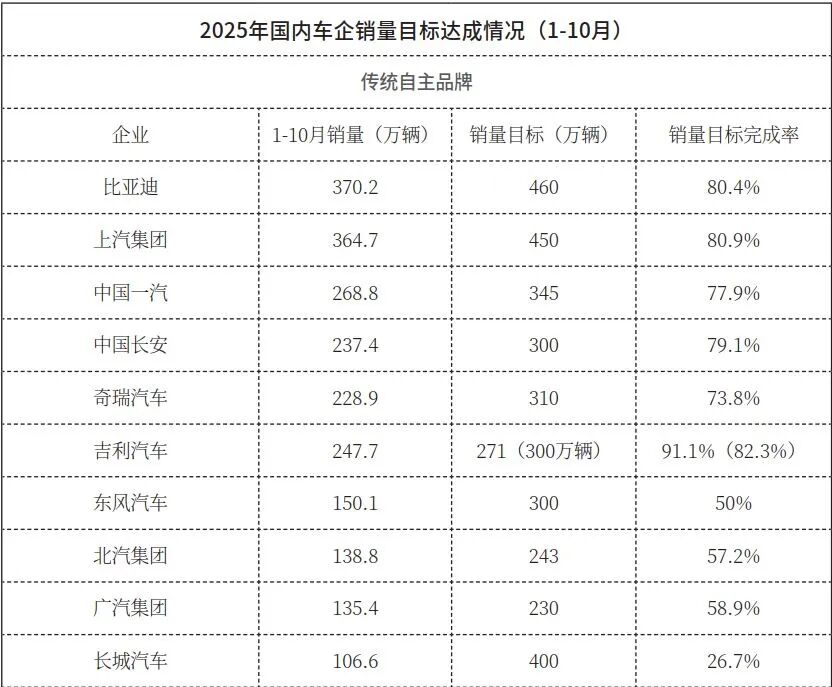

According to the latest data released by companies, among the new-force companies and subsidiaries of traditional domestic brands, XPENG Motors reached its annual target of 350,000 units with cumulative sales of 355,000 units by October, becoming one of the first automakers to cross the finish line this year. Leapmotor also achieved remarkable results, completing 466,000 units from January to October, reaching 93.2% of its annual target, and announced on November 15 that it had surpassed the 500,000-unit mark, fully achieving its annual goal 45 days ahead of schedule. Additionally, Seres (NEV) and Xiaomi Auto closely followed with target achievement rates of 93.8% and 87.4%, respectively, and are expected to complete their annual sales targets in November.
In contrast, the traditional domestic brand camp shows a 'staggered' differentiation pattern. BYD, SAIC Motor, and Geely Auto form the first tier, all with achievement rates exceeding 80%, and are currently steadily moving toward their annual targets. Changan Automobile, FAW Group, and Chery Automobile are in the 70%-80% pursuit range, still needing to maintain strong momentum in the final stage. Although GAC Group, BAIC Group, Dongfeng Motor, and Great Wall Motor have all failed to break through the 60% mark in their sales target achievement rates, their sales volumes remain stable at over one million units, demonstrating solid support from their core businesses.
An analysis reveals that among traditional domestic brands, BYD's performance stands out. From January to October 2025, its cumulative sales reached 3.702 million units. With its strong market performance, BYD has virtually secured the title of the annual sales champion among domestic brands.
In the reporter's view, BYD's achievement is mainly attributed to its rich product matrix. From a product layout perspective, BYD not only offers multiple best-selling models priced under 100,000 yuan but has also successfully entered the luxury segment priced at 300,000 yuan or even 500,000 yuan and above through mid-to-high-end brands such as Denza, Fangchengbao, and Yangwang. This nearly 'comprehensive' product system precisely meets the diverse car-buying needs of current domestic consumers, providing strong support for its continued leadership.
As a traditional major automaker, SAIC Motor also demonstrated strong growth momentum in the first 10 months of 2025, with impressive cumulative sales and financial performance. In particular, its 'new three engines' of domestic brands, new energy vehicles, and overseas markets have jointly driven its growth. Among them, the rapid growth of the domestic brand segment is the most significant change for SAIC Motor.
Currently, SAIC's star models, such as the new generation IM LS6, have become a hit in the 200,000 yuan-level SUV segment, with cumulative orders for the new MG4 exceeding 60,000 units. Additionally, the first model, H5, from the Shangjie brand jointly developed with Huawei, quickly gained market recognition after its launch. The latest data shows that in October this year, SAIC's domestic brand sales reached 306,000 units, a year-on-year increase of 22%. From January to October, cumulative sales of SAIC's domestic brands reached 2.35 million units, a year-on-year increase of 29.6%, accounting for 64% of the company's total sales. This means that SAIC's foundation has shifted from joint ventures to domestic brands, giving it complete control over its development initiative.
As China's first private automaker, Geely Auto stands out with its steady sales targets. The reporter learned that Geely Group initially set a target of 2.71 million units for early 2025, but with 1.409 million units sold in the first half of the year, Geely officially raised its sales target to 3 million units in August this year.
Specifically, the Galaxy brand has undoubtedly been Geely Auto's brightest growth point in 2025, with sales reaching 548,000 units in the first half of the year, a significant year-on-year increase of 232%, contributing substantial revenue to the group. The Zeekr brand reached a cumulative delivery milestone of 500,000 units in June this year, with an average vehicle price of 300,000 yuan, demonstrating the tangible results of Geely Group's brand premiumization efforts. Although Geely is still about 523,000 units short of its final sales target, considering that its average monthly sales in the third quarter exceeded 250,000 units and that Geely plans to launch new models by the end of the year, achieving the 3 million unit target is not impossible.
Overall Market Performance Improves,
The Three Major State-Owned Enterprises Make a Strong Push
Compared to the strong growth momentum of private automakers, FAW Group, Changan Automobile, and Dongfeng Motor—the three major state-owned enterprises—face greater pressure in the final stage. However, based on the solid foundation laid in the first ten months, all three companies have maintained a steady development trend.
In terms of specific progress, Changan Automobile achieved 79.1% of its annual target with cumulative sales of 2.374 million units. Its three major new energy brands have consistently sold over 10,000 units per month for several consecutive months, showing a steady growth trend. FAW Group completed 77.9% of its annual task with sales of 2.688 million units, performing outstandingly in its domestic brands and new energy segments, which may become crucial drivers for its final push.
Although Dongfeng Motor has a relatively lower target achievement rate of 50% among the three major state-owned enterprises, its continuous investment in the new energy sector has started to yield results. According to publicly available information compiled by the reporter, in 2025, Dongfeng Motor's domestic new energy brands have developed rapidly, forming a new brand matrix consisting of VOYAH, MHERO, and eπ. Facing the final push window, Dongfeng Motor is striving to enhance its terminal performance by optimizing its product mix, strengthening channel mobilization, and increasing marketing efforts.
Among them, the second product under the MHERO brand, the M817, was officially launched not long ago. The VOYAH brand has successively introduced new models such as the VOYAH FREE+, the all-new VOYAH Zhiyin, the 2026 VOYAH Dreamer, the Zhiguang L, and the VOYAH Taishan. The eπ brand has also launched models such as the Dongfeng eπ Nano 06, the Dongfeng eπ 2026 eπ008 six-seater version, the Dongfeng Fengshen L8, the Dongfeng eπ 2026 Nano 01, the Dongfeng eπ 2026 eπ008 five-seater version, and the Dongfeng eπ eπ007+, providing consumers with a wide range of choices.
It is reported that in the 'final battle' of the 14th Five-Year Plan, Dongfeng Motor will collaborate with its domestic new energy brands, including VOYAH, MHERO, and eπ, to strive for the 2025 annual sales target of 1 million new energy vehicles. The latest sales data shows that Dongfeng Motor achieved leapfrog growth in NEV sales in October, with 112,000 new energy vehicles sold in a single month, a year-on-year increase of 42.17%. Additionally, the market 'year-end rally effect' is also expected to lay a solid foundation for Dongfeng Motor to achieve its annual target by the end of this year.
Exploring Overseas Markets,
Mainstream Automakers Actively Seek New Growth Opportunities
While the three major state-owned enterprises are making a strong push toward their annual targets, other mainstream automakers are also showing different development trends. Take Chery Automobile as an example. From January to October this year, Chery Automobile achieved 73.8% of its annual target. Although there is still a gap to its full-year goal, its strategy of continuous technological innovation and overseas market expansion has made it an important force in China's auto industry.
As a pioneer in the globalization of Chinese automakers, Chery not only achieved monthly exports exceeding 100,000 units for six consecutive months in 2025, continuously setting new records for Chinese auto exports, but also reached the milestone of 1 million exported units for the year at a historical pace in October. Currently, Chery Group has a global cumulative user base exceeding 18 million, with over 5.56 million users overseas, providing a classic model for the internationalization of Chinese brands.
GAC Group has achieved 58.9% of its annual target. Although there is a gap compared to the expected progress, it is noteworthy that its vehicle sales and revenue have achieved positive month-on-month growth for two consecutive quarters. Among them, the combined sales of its three domestic brands—GAC Trumpchi, GAC Aion, and GAC Hyper—exceeded 159,500 units in the third quarter, a quarter-on-quarter increase of 15.09%, showing positive signs of stabilization and recovery.
According to reports, GAC Group also views overseas markets as a key to breaking through. Feng Xingya, Chairman of GAC Group, emphasized in the 2025 interim report that the group will leverage its resources to expand into international markets, striving to create multiple core markets with annual sales of 50,000 to 100,000 units and global star models. From the third-quarter report, GAC Group's overseas terminal sales increased by 36.5% year-on-year in the first three quarters of this year. With the arrival of the year-end sales peak season and the advancement of the 'Panyu Initiative' integrated reform, GAC is expected to further unleash its growth potential by leveraging its systemic advantages.
BAIC Group stands out in the new energy sector, with its BAIC New Energy product matrix achieving monthly sales exceeding 30,000 units. In the reporter's view, the direct reasons for its sales surge are the precise implementation of the 'ARCFOX + XIANGJIE' dual-brand strategy and the full realization of a user-centric mindset in its key products. The all-new ARCFOX Alpha T5 launched a 'dual-power + intelligent upgrade' combination immediately after its launch, with the extended-range version priced at 109,800 yuan, breaking through the 'price barrier' of traditional mid-size SUVs. The XIANGJIE brand, a 'value benchmark' under BAIC Group, launched the XIANGJIE S9T in September, known as the 'most beautiful station wagon,' with sales reaching 6,700 units in October, securing the top spot in the luxury new energy sedan segment priced over 300,000 yuan.
More notably, Yu Chengdong, Executive Director and Chairman of Huawei's Terminal BG, has announced that the new XIANGJIE S9, set to launch in November, will be equipped with four LiDAR sensors, further enhancing its intelligent experience. This indicates that XIANGJIE aims not only to be a 'pioneer in luxury station wagons' but also to continue investing in the high-end intelligent vehicle segment.
Great Wall Motor sold a cumulative 1.066 million units in the first ten months. Although its sales target achievement rate is only 26.7%, its core business remains stable, with multiple models achieving varying degrees of positive growth. Specifically, the Haval brand has performed outstandingly: the all-new Haval Menglong achieved 'eight consecutive months' of sales growth from February to October, while the Haval Big Dog achieved 'five consecutive months' of sales exceeding 10,000 units. In the new energy segment, WEY sold 6,486 new vehicles in October, a year-on-year increase of 187.5%. Among them, the all-new Blue Mountain continued its strong sales, with 6,180 units sold in a single month, a year-on-year increase of 204.13%. Additionally, the Tank SUV series sold a cumulative 188,933 units from January to October, a year-on-year increase of 49.18%, becoming an important growth driver for the brand. If each brand can maintain its current upward momentum, Great Wall Motor is expected to further unleash its potential in the year-end push.
Currently, the Chinese auto market has entered the most critical strategic push period of the year. Automakers from different camps and with varying progress levels are adopting differentiated strategies based on their own rhythms to strive for better results. However, in the reporter's view, achieving annual targets is only a phased achievement. Currently, the focus of competition among automakers has shifted from mere sales volume to a comprehensive competitiveness encompassing systemic capabilities, technological strength, and global layout. The logic of market competition is also transitioning from 'incremental expansion' to 'stock cultivation.' Therefore, regardless of the results of this final battle, the true determinant of an automaker's future direction will still be the long-term advantages it builds during this profound transformation.
Image: From the Internet
Article: Auto Review
Layout: Auto Review


